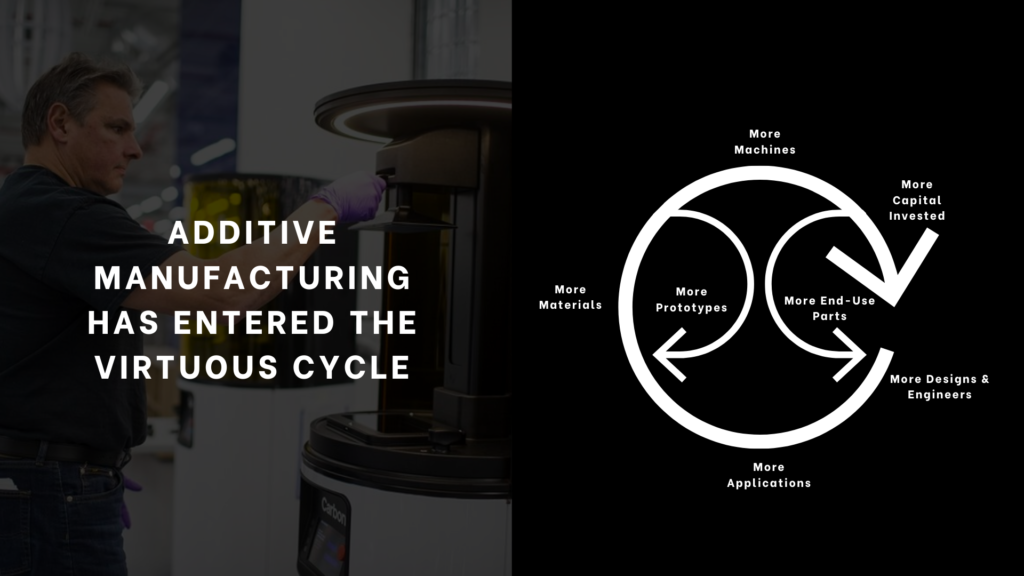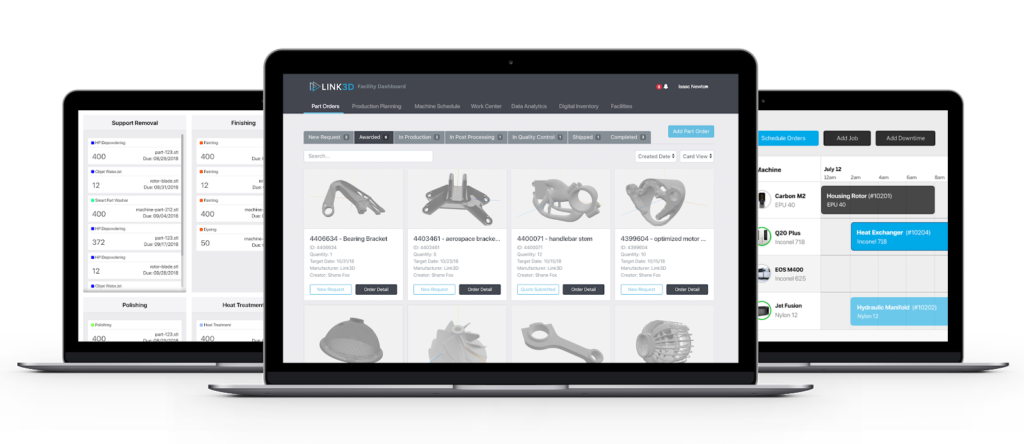When considering Additive Manufacturing for its speed, flexibility, and efficiency, it’s crucial to understand supply chain and operational optimization. That’s something we have learned from our conversation with Link3D’s CEO & Co-founder, Shane Fox.
Fox worked for a couple of technology companies in the past, but the one that marked a significant turning point in his career is Within technologies, a topology optimization software company. That’s how he got exposed to 3D Printing. “We were really on the cutting-edge of topology optimization and DfAM,” Fox recalls.
In 2014, Within Technologies was acquired by Autodesk. Fox continued at Autodesk as an additive manufacturing evangelist traveling the globe meeting with some of the most advanced Autodesk clients across key industries, including aerospace/defense, energy, automotive, medical, and consumer products. Industry agnostic challenges included operational efficiency tools, manufacturing execution systems, and quality management systems.
“What became apparent was introducing, and scaling AM was critical to the success of these industries. In these industries, a solution was needed to drive the success of this new supply chain.”, said Fox.
Link3D, founded by Vishal Singh & Shane Fox, debuted in the additive manufacturing industry in 2016 as a success enabler to the industry.
The company is acknowledged for its suite of modular solutions that are essential to organisations scaling up their AM ecosystems. Put simply, “the solution that we provide helps them to plan, manage, and optimize their AM supply chain,” explains the CEO. Simply put, “our solution is the operating system enabling the optimization of their AM supply chain.”
The “virtuous circle” of the 3D Printing industry

From an economic perspective, Fox notes, the industry is evolving in a “virtuous cycle,” a positive chain of events reinforcing the growth of the industry, meaning “the more designers design products, the more applications we will have. The more applications there are, the more materials will be developed, and the more printers will evolve or be introduced to the market“. “We are starting to see a shift in Manufacturing to mitigate our reliance on global supply chains that can be disrupted in times like these. Some of the lessons learned as a result of the COVID-19 pandemic will reinforce the growing drive across the manufacturing community for digital distributed manufacturing models enabling R&D and ultimately production to be done close to the customer and on-demand.
Manufacturing companies are emphasizing agility and resilience as strategic supply chain priorities. Achieving these characteristics requires constant and real-time visibility of an organization’s manufacturing assets. Link3D is paving the way by leveraging machine connectivity. “By integrating the real-time feedback of both build progress and build heath into our operating system, organizations can maximize their production and manage production quality, even in a decentralized production environment.”
Even though the majority of Link3D’s customers are large OEMs or service bureaus, their process maturity covers the spectrum from reactive to managed, but none have crossed over to automated. One of the most significant challenges in evolving to fully automated processes is the lack of a unified data model. For companies harnessing AM for tooling, jigs and fixtures, and prototyping as well as series production, Link3D’s operating system is a valuable solution within their ecosystem. Fox notes, “As an organization’s AM maturity develops, customers grow beyond our simpler tools – order capture, costing simulation and quoting. Their ability to leverage our advanced platform, including dynamic production planning, scheduling, and quality management enabled with IoT, and our machine connectivity becomes game-changing relative to maximizing their return on investment (ROI) and effectively managing production risk.”
“The collaboration between material producers, machine manufacturers, standards organizations and Link3D is critical.”
Shane Fox.
To help facilitate the industry’s rapid transformation, we are starting to see an unprecedented level of collaboration between machine manufacturers, materiel producers, standards organizations, and users. This collaboration will accelerate the broader adoption of AM. Improved quality, risk reduction, and reduced cost are extended positive effects of this collaboration as companies look to expand the reach of AM to mitigate supply chain risks.
The rate of innovation will continue to accelerate. This can quickly be seen in the number of new printer OEMs and printers entering the market, the evolution of machine/material combinations, and the integration and automation of post-processing. It’s not practical to expect internal IT teams to build and maintain systems to manage this pace of innovation.
To explain their role in such a situation, Fox takes the example of their collaboration with EOS. The industrial 3D printing systems manufacturer uses Link3D’s technology globally inclusive of Asia, Germany, and North America. Link3D’s use also extends to EOS’ sales and service partners.

“EOS is leveraging our software to manage the global production of benchmark parts for their customers as well as their R&D efforts. Our collaboration with EOS also extends to printer connectivity facilitating dynamic production scheduling and manufacturing quality management. Key goals of our partnership include:
- Providing EOS with a global operating system to ensure production quality and the capability to effectively manage their R&D, benchmark, and internal production programs.
- Providing an industry-leading solution to EOS and Link3D customers looking for proven, digital distributed Manufacturing operating and quality systems required to scale production.
We have a very strategic approach to our collaborations with EOS and other machine OEMs, enabling ongoing collaboration to find solutions that leverage technology advancements enabling AM industry evolution and advancement. The same strategic partnership is applied to material producers, given the increasing demand for digital material traceability. Our operating system can connect to the material management ecosystems providing digital production and testing data management during new material development and production, inclusive of batch management from virgin powder through the qualification of blended material lots.
The quality requirements driven by complexities of the AM ecosystem highlight the increasing importance of the partnership or marriage between the machine and material manufacturers, standards and quality organizations, and Link3D,” the CEO states.
Primetime for Additive Manufacturing?

Link3D provides the manufacturing industry with smart solutions that respond to market needs. However, it was hard not to raise the Covid-19 pandemic. Will manufacturing needs remain the same?
Manufacturing needs were evolving to more capital-intensive automated processes with less reliance on people, and the Covid-19 pandemic accelerated this trend. This can be seen with the rapid global expansion of AM over the course of the pandemic given the strain and, in some cases, the collapse of the supply chain. Not only has there been solidarity in support of the front-line workers and small businesses but also across the AM industry as barriers to entry for engineers are being broken, enabling AM solutions to be envisioned and ultimately driving the use of printers and materials to be leveraged in uncommon ways. The Covid-19 pandemic also highlighted our dependence on disparate and disconnected global supply chains.
“I think in the years ahead, digital transformation and successful industry partnerships will be critical enablers to the rapid expansion and adoption of additive manufacturing as the technology continues to advance and mature”, Fox concludes.
This article was originally published in the April/May issue of 3D ADEP Mag. Remember, you can post free of charge job opportunities in the AM Industry on 3D ADEPT Media or look for a job via our job board. Make sure to follow us on our social networks and subscribe to our weekly newsletter : Facebook, Twitter, LinkedIn & Instagram ! If you want to be featured in the next issue of our digital magazine or if you hear a story that needs to be heard, make sure to send it to contact@3dadept.com






